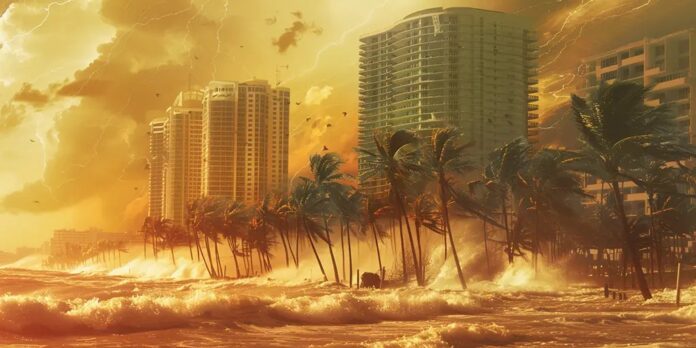It would be nearly impossible to fabricate a better fictional demonstration of motivated reasoning than the May 2025 Nature commentary titled “Hurricane risk in a changing climate — the role of uncertainty” by Adam Sobel and Kerry Emanuel. In fact, if one needed a primary source to study how scientific ambiguity can be massaged into policy certainty, this article would serve beautifully.
The authors begin by acknowledging the obvious:
“there’s also a lot that we don’t know”
about how climate change affects hurricanes. This initial concession gives the impression of intellectual humility. Yet what follows is a masterclass in rhetorical misdirection—a piece that deserves to be taught in schools, not for its science, but for its persuasive structure.
Rather than treating uncertainty as a reason for caution, Sobel and Emanuel treat it as a trigger for urgency. They write,
“In general, uncertainty increases risk”.
This sounds profound until you realize it’s a tautology masquerading as logic. More uncertainty does not inherently increase actual risk—it increases the range of possible outcomes. But in the world of policy-driven science, this range is always framed around the worst case.
This is how one turns “known unknowns” into leverage for sweeping intervention.
The authors proceed to break down various hurricane risk factors
“in roughly decreasing order of confidence,”
a rhetorical trick designed to create a gradient of believability. It starts strong—with precipitation—then deteriorates into hedging and handwaving, without ever breaking the narrative thread.
On rainfall, they write:
“Scientists are confident that rainfall associated with hurricanes will increase in a warmer climate”
because
“more water vapour can be held in a warmer atmosphere”.
This is true in theory. But the authors make no effort to quantify it, nor do they explain how this theoretical increase translates into measurable damages—particularly when modern infrastructure, forecasting, and drainage systems have vastly improved.
On coastal flooding, the authors rely heavily on sea-level rise, noting that “
global sea level has risen by around 20 centimetres since pre-industrial times”
and that flooding
“would have been less”
a century earlier during events like Hurricane Sandy. But they gloss over local variability, subsidence, and historical storms of equal or greater magnitude. Context is everything—and here, it’s notably absent.
Theoretical Constructs and the Mirage of Consensus
One of the more revealing passages deals with wind speeds. The authors admit that
“the wind-intensity increase is harder to observe than sea-level rise,”
yet assert,
“multiple lines of evidence support an increase in wind speeds as an important factor contributing to increased risk”.
That’s not science; that’s theology. Evidence that can’t be reliably observed shouldn’t be used to underwrite regulatory or economic policy.
On storm frequency, they are more candid:
“Researchers do not yet fully understand what controls the global frequency of hurricanes, and models produce conflicting predictions”.
But instead of urging restraint, they dive deeper into the weeds of uncertainty, hoping the complexity will obscure the weakness of the claim.
The Atlantic hurricane uptick? Not due to greenhouse gases, they say—it’s likely
“more a response to decreasing air pollution than to increasing greenhouse gases”.
This claim directly contradicts the mainstream narrative that CO2 is the prime villain. And yet, they deploy it only to claim that the hurricane surge is real—even if the carbon culprit isn’t.
A Moving Goalpost, Expertly Camouflaged
Their discussion of aerosol impacts is perhaps the article’s most candid moment.
“In the mid-twentieth century, aerosols… had a cooling effect by reflecting solar radiation away from Earth,”
they explain.
“This effect has reduced as clean-air policies have taken hold. Simply put, more solar radiation means warmer seas”.
Fair enough—but what follows is the quiet pivot:
“If that explanation is true, it implies that the recent increase in Atlantic hurricane intensity is unlikely to continue,”
yet also “
that the dearth of Atlantic hurricane activity in the 1970s and 1980s is unlikely to be repeated”.
In short: whatever happens, the authors’ thesis remains valid. Heads they win, tails you still lose.
This is textbook motivated reasoning. The causal arrow is bent and twisted until it points wherever the authors need it to—toward more funding, more intervention, more regulation.
Models, Models Everywhere—And Not a Truth to Hold
Finally, they return to models.
“Earth-system models project that greenhouse gases will tend to further increase equatorial eastern Pacific sea temperatures… This is consistent with the expectation of low Atlantic hurricane activity in coming decades,”
they write—only to immediately undercut it:
“But observations have instead demonstrated the opposite”.
So let’s tally that up: the models say one thing, reality says another, and the authors still walk away claiming credibility. In any other field, this would trigger a re-evaluation of assumptions. In climate science, it’s just another paragraph.
Conclusion: The Climate Policy Ouroboros
The final message of the piece is a kind of circular logic loop: uncertainty justifies concern, concern justifies policy, and policy then retroactively validates the concern.
“Our overall opinion is that present US hurricane hazard is greater than the longer-term historical average,”
the authors write, due to
“well-understood factors that increase hazard and poorly understood ones that might increase it”.
Translation: we don’t know what we don’t know, but let’s act as if we do.
This is not empirical science. This is moral theater, staged with peer-reviewed props. It takes a complicated, poorly understood, regionally inconsistent phenomenon like hurricane frequency and repackages it as a policy cudgel.
And therein lies the real danger. Not from the storms—but from the political winds that follow them.
Related
Discover more from Watts Up With That?
Subscribe to get the latest posts sent to your email.



